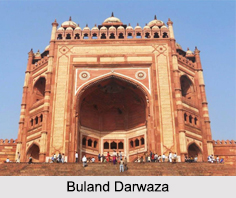 Buland Darwaza or the “Gate of victory†was built in 1601 A.D. by Mughal Emperor Akbar to commemorate his victory over Gujarat. It is the main entrance to the palace at Fatehpur Sikri. Buland Darwaza is located in the Fatehpur Sikri, in the Agra district of the Uttar Pradesh. The Buland Darwaza, approached by 42 steps and 53.63m high and 35 meters wide, is the highest gateway in the world and an astounding example of the Mughal architecture.
Buland Darwaza or the “Gate of victory†was built in 1601 A.D. by Mughal Emperor Akbar to commemorate his victory over Gujarat. It is the main entrance to the palace at Fatehpur Sikri. Buland Darwaza is located in the Fatehpur Sikri, in the Agra district of the Uttar Pradesh. The Buland Darwaza, approached by 42 steps and 53.63m high and 35 meters wide, is the highest gateway in the world and an astounding example of the Mughal architecture.
History of Buland Darwaza
In the year 1573, the Emperor Akbar built this huge monument to commemorate his victory over Gujarat. It was built by Muhammad of Ghazani. It took almost 12 years to complete the structure. Buland Darwaza forms the main entrance of the palace at Fatehpur Sikri and stands as a fine example of the architectural brilliance of the Mughal Empire.
Architecture of Buland Darwaza
The semi octagonal structure of Buland Darwaza is 40 meters high and is approached by 42 steps. It is 40.84 m high and was built on a platform that was 13.52 m high. On the top it is dominated by the magnificent pillars and chhatris. The grand recessed central arch forms the most attractive part of the monument. The arch resembles the pattern of the Jama Masjid. It is built in red sandstone and is beautifully out-layered by the white and black marble. The inscription throws light on the Akbar"s religious broad mind.
It is semi octagonal in plan and two smaller triple-storeyed wings on either side. It has three kiosks on its top surrounded by 13 smaller domed kiosks. There are smaller turrets surrounding the gateway. The principal arch stands in the centre of three projecting sides and topped by a dome. The central archway is richly ornamented with a broad band of yellow buff sandstone, bordered by red sandstone panels and two square panels on its bottom on either side with white and black marble inlay work.
A Persian inscription on eastern archway of the Buland Darwaza records Akbar"s conquest of Uttar Pradesh and the victory in Gujarat in 1573.
Visiting Information of Buland Darwaza
To reach this magnificent Gateway, the nearest railhead is Fatehpur Sikri Railway Station (around 1 km) and nearest airport is Agra Airport (40 km). One can also avail state buses or private bus services and cabs from Agra and neighbouring regions to reach this place.



















